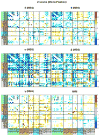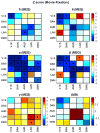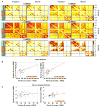Natural scenes viewing alters the dynamics of functional connectivity in the human brain
- PMID: 23891400
- PMCID: PMC3893318
- DOI: 10.1016/j.neuron.2013.06.022
Natural scenes viewing alters the dynamics of functional connectivity in the human brain
Abstract
Spontaneous fMRI fluctuations are organized in large-scale spatiotemporal structures, or resting-state networks (RSN). However, it is unknown how task performance affects RSN dynamics. We use MEG to measure slow (∼0.1 Hz) coherent fluctuations of band-limited power (BLP), a robust correlate of RSN, during rest and movie observation and compare them to fMRI-RSN. BLP correlation, especially in α band, dropped in multiple RSN during movie although overall topography was maintained. Variability of power correlation increased in visual occipital cortex, and transient decrements corresponded to scenes perceived as "event boundaries." Additionally, stronger task-dependent interactions developed between vision and language networks in θ and β bands, and default and language networks in γ band. The topography of fMRI connectivity and relative changes induced by the movie were well matched to MEG. We conclude that resting-state and task network interactions are clearly different in the frequency domain despite maintenance of underlying network topography.
Copyright © 2013 Elsevier Inc. All rights reserved.
Figures








References
-
- Arfanakis K, Cordes D, Haughton VM, Moritz CH, Quigley MA, Meyerand ME. Combining independent component analysis and correlation analysis to probe interregional connectivity in fMRI task activation datasets. Magn Reson Imaging. 2000;18:921–930. - PubMed
-
- Bartels A, Zeki S. Brain dynamics during natural viewing conditions—a new guide for mapping connectivity in vivo. Neuroimage. 2005;24:339–349. - PubMed
-
- Berger H. On the electroencephalogram in man. Arch Psychiatr Nervenkr. 1929;87:527–543.
Publication types
MeSH terms
Substances
Grants and funding
LinkOut - more resources
Full Text Sources
Other Literature Sources

